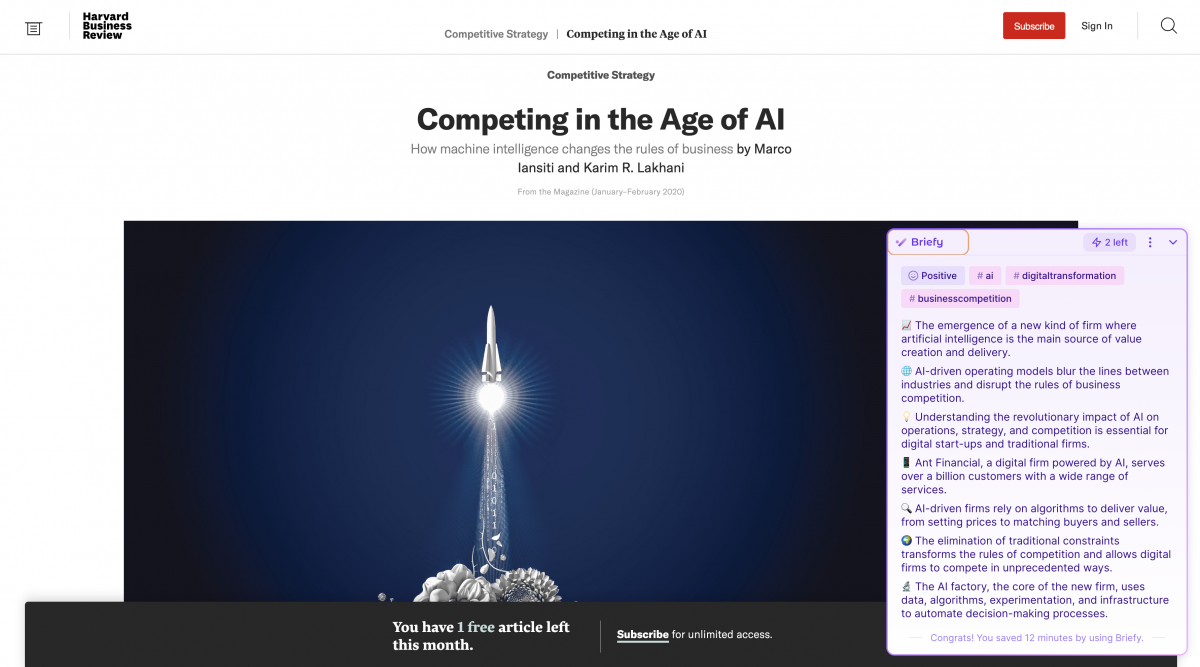Let’s be real for a sec – who’s got the time (or energy) to go through hours of content these days? We’re all out here, drowning in a sea of never-ending tabs, articles, and videos. But I found this tool – Briefy – which was launched about a month ago, and despite being in the early stages, it holds a lot of promise to help us in our student life.
So far, Briefy is all about keeping it simple and user-friendly. There is luckily no need to spend time on complicated stuff like API keys or prompt settings. I tried it and it’s a quick download, a Google sign-in, and installation of a (chrome) extension, and you’re ready to get summarizing (Briefy, 2023).
So, how does it work? After having installed the Briefy extension, go to a website with a text you’d like to summarize, look for the Briefy button (appearing if the extension is activated), and a pop-up lays out all the main points in easy-to-read bullets, without having to click away from the page (Briefy, 2023).
Even though it’s a very new tool, compared to more established ones like ChatGPT-4, Briefy shows a lot of promise for providing quality summaries and a super smooth usability. But it also comes with a couple of limitations (which I’m sure the team behind Briefy is already working on): so far, Briefy is only available on websites and is not yet able to handle very long articles, such as the academic ones we have to read. But this gives also a lot of room for improvement! Moreover, especially for more visual students, it would be amazing if Briefy developed into a tool that can not only provide us with quality summaries but also charts or mindmaps, all available to go on our phones or tablets.
Also, when using tools like Briefy, we should keep in mind that such AI summary tools can struggle to balance between being overly general or too specific and not grasping the context or what we deem important (Altmami & Menai, 2022; Widyassari et al., 2022). Moreover, despite improvements in natural language processing, it can also still be possible that these AIs lack deep semantic understanding, meaning that the summaries provided can be technically correct, but might still miss implict meanings which are present in the original article (Silva et al., 2019).
So, I personally believe that this new tool isn’t just a potential timesaver; it can turn into a starter gun for deeper dives into how we consume and process with the digital world.
Altmami, N. I., & Menai, M. E. B. (2022). Automatic summarization of scientific articles: A survey. Journal of King Saud University-Computer and Information Sciences, 34(4), 1011-1028.
Briefy. (2023). Briefy – AI-powered content summarizer. Retrieved October 20, 2023, from https://briefy.ai/
Silva, V. S., Freitas, A., & Handschuh, S. (2019). On the semantic interpretability of artificial intelligence models. arXiv preprint arXiv:1907.04105.
Widyassari, A. P., Rustad, S., Shidik, G. F., Noersasongko, E., Syukur, A., & Affandy, A. (2022). Review of automatic text summarization techniques & methods. Journal of King Saud University-Computer and Information Sciences, 34(4), 1029-1046.

